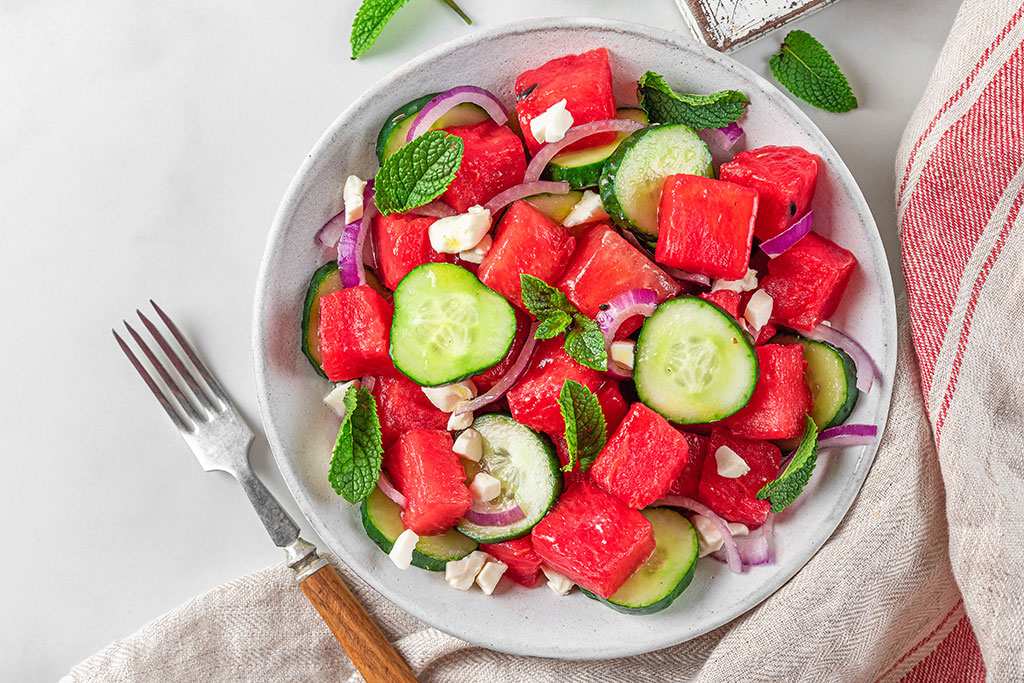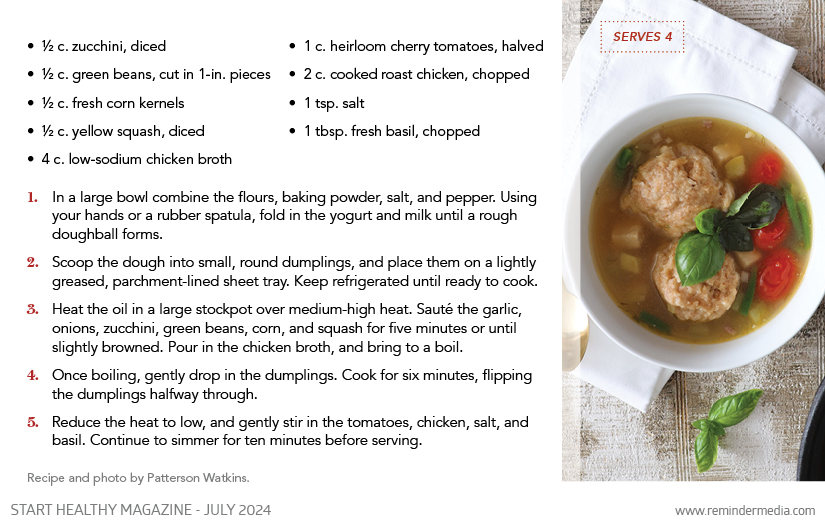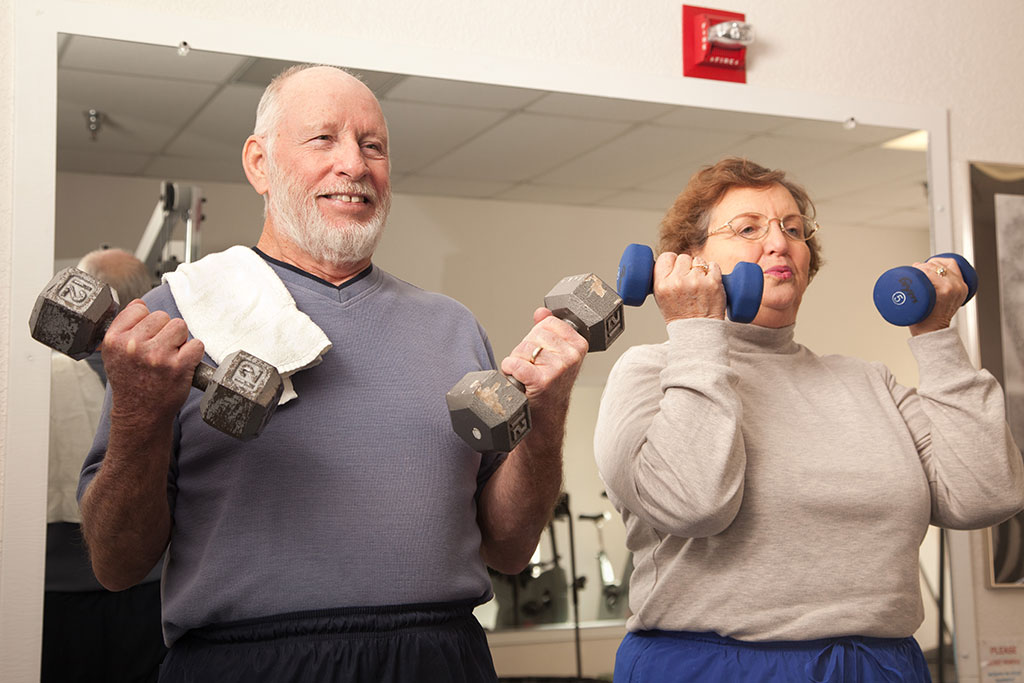Summer is a time of vibrant colors and refreshing breezes, but it also offers numerous fresh whole foods that are both rich in essential nutrients and utterly delicious. With a closer look at the best hydrating options and two comforting meals that are bursting with bright flavors, this guide can help you make the most of the season’s offerings.
Explore the benefits of whole foods, and discover what fruits and veggies can help you beat the summer heat.
This delicious dish is packed with fresh veggies like zucchini, green beans, and squash, making it perfect for any night of the week.
Featuring pineapples, bananas, and coconut milk, this tropical breakfast bowl is chock-full of healthy goodness.
As you spend time basking in the summer sun, it’s important that you make sure to look after your well-being and stay hydrated. The best way to do so is by drinking the daily recommended amounts of water, but you also have the option to indulge in some of the season’s best whole foods. Loaded with nutrients your body needs, they can keep you feeling refreshed and energized so you’re ready to take on your next adventure.

The term “whole foods” refers to natural, unprocessed, or minimally processed foods that are as close to their original form as possible, meaning they haven’t been canned or precooked. Think of options such as fruits, vegetables, whole grains, nuts, seeds, legumes, and unprocessed meats and fish. Because these foods are often fresh off the stand, they’re loaded with essential vitamins, minerals, and other nutrients—which processing generally strips them of—while being free of additives, artificial flavors, and preservatives. By choosing whole foods whenever possible, you can create a more balanced diet that may help strengthen your immune system, prevent chronic diseases, and improve your overall well-being.

Another huge benefit of many whole foods, especially during summer, is that they have a high water content. If you’re searching for creative ways to keep cool this season, here’s a closer look at some fruits and veggies that can both fill your diet with various vitamins and minerals and help you stay hydrated.
Berries
Various berries, including strawberries, blueberries, and raspberries, are at their peak in summer and are packed with water, antioxidants, fiber, vitamins, and minerals. Incorporating these delicious foods into your meals doesn’t have to be complicated: simply add a handful to a yogurt parfait or bowl of oatmeal or blend a few different types into a breakfast smoothie.
Cucumber
Made up of about 96 percent water, cucumbers are a refreshing summer staple that is low in calories and provides some potassium, magnesium, and vitamin K. Take advantage of this fruit’s benefits by tossing a few dices into your favorite salad or simply adding a slice or two to a glass of water.
Leafy greens
Using leafy greens like lettuce, spinach, cabbage, or kale in your meals adds a hydration boost along with essential vitamins and minerals, including vitamins A and C, iron, calcium, and magnesium. Better yet, regularly consuming these veggies may improve your brain health and reduce your risk of cancer and heart disease. Not a fan of salads? You can also mix a few handfuls into a light summer soup or sauté some for a delicious side dish.

Pineapple
At about 85 percent water, pineapples are a tasty and nutritious way to replenish your body. They’re rich in vitamin C and antioxidants, which can help give your body the boost it may need to fight off different illnesses, and are full of various enzymes that may aid digestion. Try adding fresh pineapple to your morning smoothie or grilling up thick slices to serve alongside your favorite meat.
Tomatoes
The tomato is a nutritional powerhouse that’s ripe for picking during summer. At about 94 percent water, it’s a great source of fiber (about 1.2 grams per small tomato), potassium, and folate and is high in vitamins C and K. Incorporate tomatoes into salads, sandwiches, or sauces for a hydrating and flavorful addition.
Watermelon
Bursting with both flavor and hydration, there’s a reason watermelon is a summertime favorite. This juicy fruit is around 92 percent water and, as a bonus, is rich in antioxidants, fiber, and vitamin C, making it a perfect food to indulge in this season. Cut one in half and dig in with a fork, or add it to a fruit salad for a fresh treat.
Zucchini
Besides being hydrating, zucchinis are also great for fiber—a cup of chopped zucchini equals about one gram of fiber and has around only twenty calories. They’re a simple way to bulk up a stir-fry or soup (as demonstrated in the following recipe) to help you feel full and satisfied this season.
By incorporating these whole foods into your summer routine, you can stay refreshed, energized, and healthy all season long. So get creative with your cooking, and embrace the bounty of nature’s best offerings!
written by patterson watkins
photos by patterson watkins
Whole-wheat dumplings are simmered with a farmers market worth of fresh seasonal vegetables and tender roast chicken for a wholesome meal that’s packed with both flavor and nutrition.

Serves 4
Tips: All vegetables are welcome—add in any of your favorites for a deliciously customizable dish. Omit the chicken and use vegetable broth instead of chicken broth for a vegetarian version.


photos by shana smith
This recipe combines pineapple and coconut for a delicious breakfast you’re sure to love. After all, what’s better than waking up to a small taste of tropical paradise?

Makes 1 bowl


As your body’s foundation, your bones are critical to your well-being, providing support, anchoring your muscles, and allowing you to move. You may be surprised to learn, however, that after about the age of just thirty, you can start losing bone mass due to a variety of factors. The good news is that there’s still plenty you can do to protect these skeletal components—by regularly performing a few simple exercises, you can make them stronger and reduce your risk of fractures both now and later in life.

Exercise is most commonly associated with muscular and cardiovascular health, but it can hugely benefit your bones as well. As you work out, you put stress on your bones, which, in turn, encourages them to become stronger and denser. Naturally, living a sedentary lifestyle may result in the opposite: your bones can grow weaker, leading them to become more fragile.
Research shows that filling your days with physical activity is one of the best defenses against developing osteoporosis, a bone disease characterized by weak and brittle bones. Even if you already have some bone loss, regular exercise can still slow the progression and improve your balance so you are less likely to fall. Just be sure to check with your physician before beginning any new fitness program to ensure that it’s right for you.

The best regimen for increasing bone strength is one that includes a mix of weight-bearing, impact, and resistance exercises. Regarding the first, any exercise that requires you to support the weight of your body, such as playing a sport, climbing stairs, or even completing household chores, qualifies as weight-bearing; many of these provide impact as well. High-impact activities like running will contribute more to your bone health, but low-impact ones like walking or using an elliptical machine can also be beneficial, as can ones that involve quick movements, such as aerobics or jumping rope. And to incorporate resistance into your routine, try lifting weights; you can start out slowly by using handheld or ankle ones before progressing to heavier options. Or you could exercise with resistance bands or do a few push-ups or pull-ups for similar benefits. Aim to engage in some bone-strengthening exercises a few times a week to get the best results.
As you get older, it’s also a good idea to focus on your balance and stability, such as by swimming or doing yoga. Such exercises will keep your muscles and joints strong and flexible to help you remain agile and steady on your feet and avoid injuries.

For those just beginning a fitness program, consider these easy bone-strengthening moves to start. You can then work your way up to more difficult ones as your stamina and strength improve.
Walking
Whether you take a brisk stroll through your neighborhood or find a way to walk inside your house, the key is to move. If you prefer the latter, you could purchase an inexpensive walking pad to use in your home—place it by a table or something sturdy you can hold onto for support. Alternatively, you can simply walk in place for a few minutes.
Tennis ball squeezes
Hold a tennis ball (or a ball that’s easy to squeeze) while sitting or standing. Squeeze it as tightly as you can two to three times before slowly relaxing your grip. Do a few repetitions, resting for a minute or so in between each.

Bicep curls
Standing with your feet hip-width apart, engage your abdominal muscles. Hold a dumbbell in each hand, and relax your arms at either side of your body with your palms facing forward. Keeping your shoulders relaxed and your elbows tucked close to your body, lift the weights up toward your shoulders. Remember to exhale while doing so. Lower the weights to their starting position, and repeat. Note: Be sure to choose dumbbells you can lift at least ten times with proper form. The last three repetitions should also require at least some difficulty.
Chair squats
Place a chair against a wall, and then slowly squat down until you are almost sitting, keeping your knees bent and your feet flat on the floor. Stand up slowly, keeping your back and shoulders straight while making sure not to use your arms to help push yourself up. Repeat the process up to five times.
Single-leg balance
Find a level spot near something, such as a table, you can hold on to if you lose your balance. Stand on your right foot, keeping your knee facing forward. Lightly bend your left knee, raising your left foot off the ground. Hold this position for thirty to sixty seconds, keeping your back straight. Repeat this move a few times, and then switch to your other leg. You can also try balancing on a foam pad to make this exercise more challenging.
Sticking to a regular fitness routine is a wonderful way to augment your bone health. Aim to do something beneficial every day, whether it’s dancing to your favorite song, tending to the flowers in your garden, or participating in a game of pickleball. Your bones will thank you for it!
Many older Americans grapple with the challenge of maintaining financial security on a fixed or limited income during retirement, especially as the cost of living, including health care, continues to rise. However, with a few smart-money management strategies, you can be better equipped to effectively create a budget and manage your debt, in turn taking control of your finances and gaining greater peace of mind.

To start, it’s essential to know all the factors that will influence how you allocate your money each month. Even if you have an existing budget, reevaluating these categories will help ensure that you haven’t overlooked any recent changes in your funds or expenditures that may require some adjustments.
First, tally up your total income, whether it comes from social security, a retirement account, a job, or another source. Then note where it goes: fixed expenses such as your mortgage, debt, and insurance premium payments; variable expenses including food and utilities; periodic costs like maintenance, repairs, and property taxes; and discretionary spending for clothing, travel, entertainment, and gifts. With a clear understanding of how much money you have to work with and what you need to put it toward, you can better build or tweak your budget to meet all your needs.

Now that you have your budget established, your next step is to monitor how well you stick to it. A good way to do this is by tracking your income and expenditures with a budget calendar—you can note upcoming paydays, bills, and purchases and record transactions as you make them. This will allow you to stay on top of deadlines and assess your spending in real time so you can see if anything needs to be adjusted. You can also consider consulting with an accountant or financial advisor to help target areas where you can reduce your expenses or even capitalize on assets you may be able to monetize, such as the equity in your home.

Though some expenses are more significant than others, even the smaller ones can add up, affecting your intended budget. Here are some simple ways you can cut back in your daily living.
Rethink your telecommunications
If the fees associated with your TV, phone, and internet services are starting to feel exorbitant, reassess your needs to see where you can cut costs. For example, you could check with your providers to see if they offer specials for adults over fifty-five or look into bundling all your services together rather than paying for them individually. You may also find it cost-effective to replace cable with streaming services or a streaming device such as the Amazon Fire TV Stick. And if you find you use your cell phone more than your landline, it may be time to simply cancel the latter.
Meal prep wisely
Dining out can be expensive, making home cooking generally more budget friendly (even with sky-high grocery prices). Whenever possible, plan your meals at the start of each week so you can optimize your grocery budget and avoid the costly last-minute rush of having to go buy something to eat. Keep costs low as you shop by using store coupons, looking for sales, and comparing prices between well-known and off-brand items—the lower-cost brands can be just as good as the more expensive ones. Finally, be mindful of purchasing too much at one time to prevent throwing away expired foods.
Monitor utilities
If high utility bills are cutting into your budget, evaluate your usage to determine where you could potentially save. For example, your energy bills will naturally be higher in winter and summer, but there are still several strategies you can use to help reduce them, including:
Seek out senior discounts
Explore savings on everyday expenses such as groceries, food, and entertainment to increase your discretionary income; sites like the Penny Hoarder can help you unearth these types of discounts. In addition, take advantage of programs like SilverSneakers, which offers reduced gym fees or even free memberships, GoodRx to save on prescriptions and other health-care items, and AARP for prescription, vision, and hearing discounts as well as savings on travel and entertainment. And don’t be shy—when in doubt, ask a retailer or service provider if they offer a senior discount.

Given the impact of inflation and rising taxes—both real estate and federal—it can be challenging to manage household costs, especially on a fixed or limited income. Luckily, there are many money-saving solutions in this area. For instance, some states offer a property-tax exemption for those aged sixty-five and older. If you have equity in your home, you could also consider tapping into it through options like a reverse mortgage or a home equity loan to help cover expenses. Finally, downsizing may be a viable option if your mortgage, taxes, and upkeep have become a financial burden.

Are you paying the right amount for your insurance? This question is especially important for older adults, as navigating different policies like life, health, Medicare, prescription drug programs, and long-term care can be complex—and expensive. To help manage and budget for these potential costs:
Assessing your budget and how you can more effectively allocate your funds can help keep your finances in check and create greater stability through your retirement years. Consider seeking out the assistance of a financial advisor, who can assist you in planning and sticking to your financial goals.
July officially ushers in the dog days of summer, a time for lounging lazily by the pool, hosting get-togethers, and vacationing. However, enjoying all this fun to the fullest requires preparation—especially regarding your health. Keep the good times rolling by learning how to recognize, prevent, and, if need be, remedy these all-too-common seasonal health hazards.

The sun can be your best friend or worst enemy over these next few months—even as its rays provide comforting warmth, they can also expose you to serious problems. Perhaps the most common of these is sunburn. Every year, about one-third of adults experience it, with over 33,000 making ER visits. First-degree sunburn is relatively minor, making the skin feel super sensitive and, well, burned. However, the next level can involve symptoms like blisters and swelling, potentially mixed in with those of heat illness. To protect yourself, cover up or use sunscreen on all exposed areas from head to toe. And if you do get burned, stay out of the sun, cool your skin with creams (preferably aloe based), and hydrate.
Speaking of, dehydration can easily sneak up on you as you lose yourself in summertime bliss. Symptoms can range from the expected (dry mouth, thirst, and fatigue) to the serious (urinary, kidney, and blood pressure problems). If you’re spending time outdoors, even if you’re not in direct sun, you should replenish frequently with plenty of liquids and water-dense foods like berries and melons. (Check out the guide to whole foods and accompanying recipes in this issue for some ideas!) Additionally, when the weather’s super hot or you’re extra active, you’ll need to drink more to compensate for your additional fluid loss. Just make sure to stick to water instead of caffeinated drinks, sodas, or alcohol since these will likely only make your dehydration worse.
An often underdiscussed and unexpected heat-related problem is food poisoning, which is more common in summer because bacteria thrive in hot temperatures. To help prevent foodborne illnesses, always prep, cook, and store food properly per CDC guidelines and avoid letting let it sit outdoors for more than two hours—and only one hour if the temperature is above 90 degrees.

Utmost care should always be taken in and around pools, but even then, a common malady can still strike: swimmer’s ear. It’s a bacterial infection that affects millions of people each year, especially children, and it occurs more often in summertime because people are frequently in water and the amped-up humidity improves the odds of bacteria growth. For prevention, common sense rules—keep water from entering your ears with a bathing cap, and dry them immediately after showering or swimming. And if you find your ear has become itchy, red, or swollen, has drainage, or hurts, see your doctor. Upon diagnosing you with swimmer’s ear, they can treat it with simple antibiotics.

It may come as a surprise, but you can get sick in summer thanks to the prevalence of certain viruses, with enteroviruses such as hand, foot, and mouth disease and even the flu being relatively common afflictions. And while kids may not be in school, both they and adults may still have to deal with highly contagious pink eye. To minimize your risk of catching something, just do as you would in cold-weather months—wash your hands thoroughly and frequently, and don’t share items like towels. Of course, there are also other serious and more common summer illnesses to worry about, thanks to . . .

Summertime is a breeding ground for many tiny creatures, which makes knowing the risks involved paramount. Mosquitos, for example, are mostly regarded as a mere annoyance that you can simply swat away on sight. However, they can transmit the West Nile virus and other diseases through their bites, so you should also take proactive measures, such as preventing or avoiding areas of standing water and wearing repellant.
You can likewise protect yourself against ticks—another common summertime nuisance, which can transmit Lyme disease—by prioritizing coverage. Besides using repellent, wearing long sleeves, pants, and a hat while in grassy or wooded areas makes it difficult for these creatures to latch on to your skin. After being outdoors, be sure to thoroughly check your body, even your scalp, for them. If you find a tick on you, use tweezers to grab it close to where it’s attached and pull it out firmly but steadily. Then dispose of it by flushing it down your toilet or putting it in a sealed bag (never crush it with your fingers), wash the area, and monitor your health in the coming days and weeks.
In addition, an estimated 500,000 people go to the emergency room each year because of insect stings. To minimize the odds of attracting bees, wasps, hornets, and the like, cover your food when outdoors and seal any cracks around your home’s exterior, where they like to build their homes. And if one comes your way, don’t be combative—flailing at it out of fear will likely make it get hostile and sting you. In the event that you do get stung, simply remove the stinger by scraping it with a fingernail or credit card and then clean the area with soapy water. You can use hydrocortisone to help with the pain and inflammation, but if you notice signs of an allergic reaction, such as fever, nausea, trouble breathing, or dizziness, seek medical help immediately.

Arguably, nothing in summer is more taxing than having a reaction to poison ivy, poison sumac, or poison oak—the unending itchiness! Be on alert when you’re out and about, keeping in mind the mantra “Leaves of three, let it be” (though sumac is actually much leafier). This advice also applies to your four-legged friend if they join you; while cats and dogs are immune to these plants’ rash-causing oil, urushiol, they can still transfer it to you.
If you think you’ve touched one of these irritating plants, washing the area right away can prevent the notorious bumps from forming. Also, follow the age-old wisdom of not scratching the affected area since doing so can spread the oil to other parts of your body and even cause infection.
You’ve undoubtedly heard that an ounce of prevention is worth a pound of cure—and during summertime, this health equation multiplies. Through awareness and preventative action, you can better avoid these common issues and enjoy the season to the fullest.
*For any serious health concerns, contact your doctor immediately.







